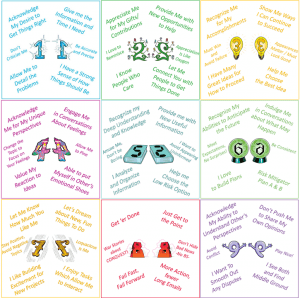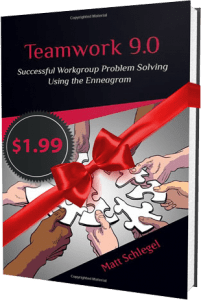
This is a video of an abbreviated version of a talk I gave at the 2020 Kindness Matters Conference. I share how to build rapport using the Enneagram. This guide will help you build relationships with people who have different Enneagram styles than your own, promoting style diversity.
Here is a transcript of the talk:
[Slide 1 – Title Slide]
It’s more important than ever that we learn to welcome a diversity of styles among our friends, family and teammates.
In this talk, I will share with you a tool called the Enneagram that I use for building rapport and trust with others who have different styles than my own.
[Slide 2 – The Enneagram]
The Enneagram is commonly used as a personality dynamics system. The system describes nine distinct behavioral dynamics. It’s extremely useful and valuable for understanding yourself, your friends, family and team members, and the interpersonal dynamics that occur.
Today, I will be sharing how to build rapport with others using a technique called mirroring, with an Enneagram twist.
[Slide 3 – Mirroring]
Mirroring is a phenomenon that occurs when we communicate with others—it’s a natural rapport-building mechanism by which we reflect back verbal and nonverbal cues. Those cues include posture, arm placement and speech patterns, among others.
Have you ever noticed during a conversation that you’ve positioned your body in the mirror image of the other person? That’s mirroring in action. Mirroring is the way we tell the other person, “Hey, I’m like you; we’re birds of a feather.” It’s our instinctual method for building rapport.
At an Enneagram workshop I conducted, I asked the group to think about their best friends in high school and guess what Enneagram type they were. As we went around the room, we discovered a pattern—most everyone concluded that their best friend was the same Enneagram type as themselves.
It’s easy to build rapport with someone when you are reflecting back their Enneagram style. Knowing the power of mirroring, why not use this technique deliberately and consciously for building rapport? By knowing each of the 9 distinct Enneagram styles, you can adjust your own style to better match that of the person with whom you are building rapport.
Let’s step through each Enneagram Type
[Slide 4 – Type 1]
In order to mirror, there must be something to reflect. Listening is the most important of rapport build skills.
Enneagram Type 1 is often called the Perfectionist. They’re frequently the first type to point out that things aren’t right, aren’t as they should be.
How do you get Type 1s to start talking? How about with this question, “Is something wrong?” Since there’s always something wrong, this simple question will get the conversation going. To build rapport as you listen, it’s important to acknowledge the problems the 1 identifies. Don’t object. Don’t correct. Don’t deflect. Just listen and acknowledge.
Another question to ask Type 1s is, “How should things be.” Type 1s have a strong innate sense of how the world should be. Encourage your Type 1 to describe the ideal world, one without the frustrating problems. By clearly defining both the problematic world and the ideal world, the Type 1 reveals the gap between the two. Remember, this is their vision, not yours. Your job is to listen and understand—doing so allows you to build rapport and trust.
[Slide 5 – Type 2]
It’s easy to build rapport with people who go out of their way to build rapport with you. Enneagram Type 2s have heart, and want to connect with you at an emotional level. How do they do that? By helping you.
Enneagram Type 2s want appreciation from those around them. The desire for appreciation compels them to seek ways to help others in return for that appreciation.
So, what’s the easiest way to build rapport with Type 2? Appreciate them! Type 2s are capable of receiving boundless amounts of gratitude. Try it yourself. I’ve never found a limit. This is the key to building rapport and trust with Type 2.
[Slide 6 – Type 3]
Enneagram Type 3 tends to minimize attention to emotions and feelings, both their own and the feelings of others. Clearly, building rapport on an emotional level is not the best approach with the 3.
They do want to succeed and appear successful. And, therein lies the key to rapport building with Type 3s.
Enneagram Type 3s are highly conscious of appearances and will respond well to mirroring. They like to surround themselves with achievement-oriented people who exhibit trappings of success—nice clothes, nice car, nice job, etc. Mirroring these signs of success while demonstrating your own ability to work hard and achieve success will put you in good stead with the 3.
Also, recognizing and acknowledging the 3 for their successes that they’ve achieved is a key to building rapport with Type 3.
[Slide 7 – Type 4]
Enneagram Type 4 has the innate ability to “feel” the emotional content of the world, both what is present and also what is missing. Having conversations about feelings is when rapport building takes place with Type 4.
Mirroring with Type 4 requires conversations about feelings. In some environments and situations, conversations about feelings are not welcome. For Type 4s, those settings can be stifling. Social conversations that focus only on positivity and superficiality will not seem genuine to the 4. They yearn for something deeper. And, herein lies your opportunity to build rapport and trust with Type 4s—by finding the time to share your own feelings. Type 4 will often express deep empathy and provide unique perspectives on your situation. Acknowledging and appreciating these gifts is a key step to building rapport with Type 4.
[Slide 8 – Type 5]
For Type 5s, acquiring information and knowledge makes them feel safe. They are drawn to unorthodox topics that require profound knowledge. They enjoy immersing themselves deeply in the subject matter.
Engaging in conversations about the subject in which they are expert is when rapport building takes place with Type 5. Sharing any specialized knowledge that you have on the subject will be especially compelling for them.
While they are capable of acquiring vast amounts of data and knowledge, they often have trouble distilling it down to make a decision. This is compounded by their desire to not be wrong. Helping the 5 sort through the data to make safe decisions are conversations that the 5 appreciates and a great way to build rapport.
[Slide 9 – Type 6]
More than any other Enneagram type, Type 6 is beset with feelings of anxiety. Like a thermometer in their gut, the anxiety temperature is low when things go according to plan. But, when things don’t, the anxiety temperature rises. When building rapport with Type 6, it is best to approach them in their calm state. Otherwise, anxiety can make them confrontational and mask their ability to make meaningful and trusting connections.
Reflecting back concern about the future and discussing probabilities for different outcomes are topics of great interest to Type 6. They value these conversations and your participation is an excellent rapport building technique.
[Slide 10 – Type 7]
Wanna have some fun? Find an Enneagram Type 7! Type 7s like being around other people, and others like being around them. Type 7s make it easy to build rapport.
Enneagram Type 7s want to keep things light and fun. Engaging with Type 7 in fun conversations and activities is a great way to build rapport with them. Type 7s want to be liked, so demonstrating that you like them is also a great way to build rapport.
[Slide 11 – Type 8]
Just get to the point. To communicate effectively with Enneagram Type 8 you must be succinct. If they want more details, they’ll ask. Letting them lead the conversation will create the environment for building rapport and trust.
Enneagram Type 8s prefer action to talking. The Type 8 characteristics to reflect back to Type 8 include getting to the point, being direct, and acting decisively. Demonstrating these characteristics is an excellent rapport building strategy. They respect others with their same style and by reflecting back to them that direct, to-the-point style you can build rapport with Type 8.
[Slide 12 – Type 9]
When a situation calls for an abundance of patience, understanding and empathy, turn to Enneagram Type 9 for guidance. Masters of de-escalation, Type 9 strives to reduce conflict. Therein lies the key to building rapport and trust.
Enneagram Type 9s have the ability to understand everyone else’s perspective. How do they do that? Type 9s tend to be on the quiet side. Rather than talking, they focus on listening. By listening, they absorb everyone’s opinions and perspectives. Doing so gives them the ability to put themselves in other’s shoes and to intuit and predict how others will react in a given situation.
Enneagram Type 9 strives to minimize conflict and appreciates those that do the same. Reflecting back empathy and a consideration of others’ perspectives is an important rapport building strategy with Type 9.
[Slide 13 – Quiz]
In order to effectively reflect back the Enneagram style of others, it is very helpful to understand your own style.
Once you know your own style, then you will know what aspects to share and which to suppress as you are reflecting back the styles of others.
For instance, being a Type 6 myself, I like to think things through and ask lots of questions. These behaviors can frustrate and anger Type 8, so in my interactions with Type 8s I work to check these tendencies.
Also, I tend to couch my conclusions into context. My typical conversations start with the context and end with the conclusion as the punchline. Knowing that 8s just want me to get to the point, I flip this style on its head. I start with the punchline and only explain the context if asked. Often the 8 will have already figured out the context, and explaining that first is just wasting their time. I’ve found this an important rapport building technique with the Type 8s in my life.
If you are interested in discovering your own Enneagram type, a good first step is to take a questionnaire. You are welcome to take the complimentary quiz at enneasurvey.com.
Also, I published a series of blogs on building rapport with each Enneagram type. You can find the links to these blogs in the notes of this video.
Thanks so much for listening.
 All I ask in return, please, is that you leave an honest review on Amazon after reading it.
All I ask in return, please, is that you leave an honest review on Amazon after reading it.

